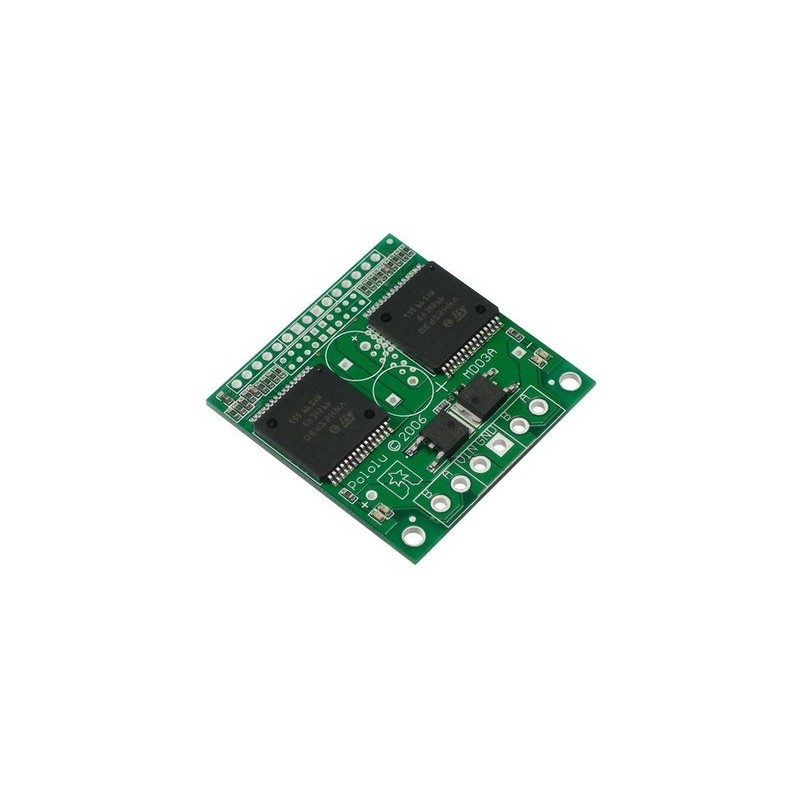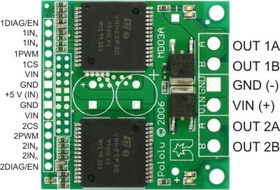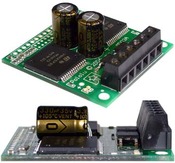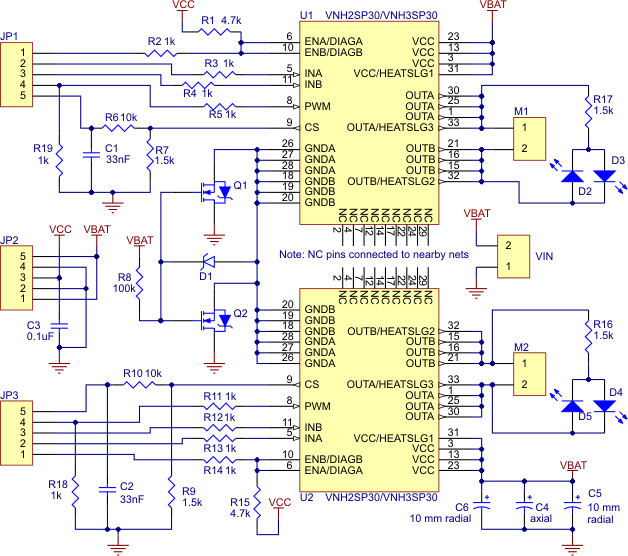

Dual VNH2SP30 Motor Driver Carrier MD03A
If you are looking to drive two high-power motors through one compact unit, these dual VNH2SP30 motor driver carriers are perfect for you. With these boards, it’s easy to get a medium-sized, differential drive robot running in no time. For even better control, the VNH2 version includes current sensing and can operate a higher PWM frequency (20 KHz) than its VNH3 counterpart.
 |
The Pololu dual high-power motor drivers are compact carriers for the VNH3SP30 and VNH2SP30 motor driver integrated circuits from ST. The board incorporates most of the components of the typical application diagram on page 8 of the VNH2SP30 datasheet, including pull-up and current-limiting resistors and a FET for reverse battery protection. (The current sense circuit is populated on both versions of the board, but only the VNH2SP30 supports current sense.) To keep the number of I/O lines down, the two enable/diagnostic lines on each chip are tied together. All you need to add is a microcontroller or other control circuit to turn the H-Bridges on and off.
Please note that we offer several other products based on these same chips, including single carrier boards for controlling one motor, the qik 2s12v10 dual serial motor controller, the TReX motor controller, the jrk 12v12 USB motor controller with feedback, and the Orangutan X2 robot controller. We also have a family of higher-power motor drivers that can deliver more current over a wider operating voltage range.
 |
In a typical application, the power connections are made on one end of the board, and the control connections are made on the other end. +5 volts must be supplied to the board through the smaller 0.1"-spaced pins; the input voltage is available at those pins as well, but the connection is not intended for currents exceeding a few amps. The diagnostic pins can be left disconnected if you do not want to monitor the fault conditions of the motor drivers. INA and INB control the direction of each motor, and the PWM pins turns the motors on or off. For the VNH2SP30 version, the current sense (CS) pins will output approximately 0.13 volts per amp of output current. If you want to add current sensing to the VNH3SP30 version, or if you want higher-accuracy current sensing with the VNH2SP30 version, please consider our ±30A ACS714 current sensor carrier.
 |
The dual motor driver PCB includes provisions for installing up to three large capacitors to limit disturbances on the main power line. Two 10mm radial capacitors may be mounted between the motor driver ICs, and an axial capacitor may be mounted between the ICs and power connections. It is generally not necessary to use all three capacitors; two radial capacitors are included with each unit. For applications that require a low profile, a single capacitor can be installed on its side as shown in the picture to the right.
Note: A 15-pin male header, three 2-pin terminal blocks, and two electrolytic capacitors are included but not soldered onto the boards. No printed documentation is shipped with these items; please see the VNH3SP30 and VNH2SP30 datasheets linked under the Resources tab.
| VNH3SP30 | VNH2SP30 | |
|---|---|---|
| Operating supply voltage (Vcc) | 5.5 – 36 V* | 5.5 – 16 V |
| Maximum current rating | 30 A | 30 A |
| MOSFET on-resistance (per leg) | 34 mΩ | 19 mΩ |
| Maximum PWM frequency | 10 kHz | 20 kHz |
| Current sense | none | approximately 0.13 V/A |
| Over-voltage shutoff | 36 V* | 16 V minimum (19 V typical) |
| Time to overheat at 20 A** | 8 seconds | 35 seconds |
| Time to overheat at 15 A** | 30 seconds | 150 seconds |
| Current for infinite run time** | 9 A | 14 A |
*Manufacturer specification. In our experience, shoot-through currents make PWM operation impractical above 16 V.
**Typical results using Pololu motor driver carrier with 100% duty cycle at room temperature.
The motor drivers have maximum current ratings of 30 A continuous. However, the chips by themselves will overheat at lower currents (see table above for typical values). The actual current you can deliver will depend on how well you can keep the motor drivers cool. The carrier printed circuit board is designed to draw heat out of the motor driver chips, but performance can be improved by adding a heat sink. In our tests, we were able to deliver short durations (on the order of milliseconds) of 30 A and several seconds of 20 A without overheating. At 6 A, the chip gets just barely noticeably warm to the touch. For high-current installations, the motor and power supply wires should also be soldered directly instead of going through the supplied terminal blocks, which are rated for up to 15 A.
This product can get hot enough to burn you long before the chip overheats. Take care when handling this product and other components connected to it.
Many motor controllers or speed controllers can have peak current ratings that are substantially higher than the continuous current rating; this is not the case with these motor drivers, which have a 30 A continuous rating and over-current protection that can kick in as low as 30 A (45 A typical). Therefore, the stall current of your motor should not be more than 30 A. (Even if you expect to run at a much lower average current, the motor can still draw high currents when it is starting or if you use low duty cycle PWM to keep the average current down.)
 |
| Schematic of the Pololu Dual High Current Motor Driver Carrier |
|---|
 |
Pololu 37D mm Metal Gearmotor Bracket Pair |
 |
Pololu Universal Aluminum Mounting Hub for 6mm Shaft Pair, 4-40 Holes |
 |
29:1 Metal Gearmotor 37Dx52L mm with 64 CPR Encoder |
Data sheet
Manufacturer BTC Korporacja sp. z o. o. Lwowska 5 05-120 Legionowo Poland sprzedaz@kamami.pl 22 767 36 20
Responsible person BTC Korporacja sp. z o. o. Lwowska 5 05-120 Legionowo Poland sprzedaz@kamami.pl 22 767 36 20
Automotive fully integrated H-bridge motor driver, MultiPowerSO-30, STM, RoHS
No product available!
DC motor driver that allows you to control the movement of two drives using the I2C interface. Board with connectors for assembly. Pololu 5052
No product available!
Brushless DC motor (BLDC) driver with speed control by potentiometer. It can operate motors powered with a voltage from 7 to 12 V with a current consumption of up to 1.2 A
The UX-52 panel brush motor speed controller is a versatile device with speed adjustment from 90 to 1400 rpm. It offers precise control of motors with an input voltage of 220VAC, featuring a solid construction and a convenient digital display.
A single-channel DC motor driver with an I2C interface. It is powered from 4.5 V to 48 V and can deliver up to 2.2 A of current. A board with soldered connectors. Pololu 5060
No product available!
A compact stepper motor controller with a TMC2225 system with an operating voltage from 4.75 to 36 V. It offers smooth, quiet operation, high efficiency, various operating modes and easy configuration. It is controlled via the STEP/DIR interface and is an ideal solution for 3D printers and similar applications. BIGTREETECH TMC2225 V1.0
A single-channel DC motor controller with an I2C interface. It is powered from 1.8 V to 22 V and can deliver up to 1.8 A of current. Board with soldered connectors. Pololu 5074
The bidirectional ESC controller enables precise control of brushed DC motors within a voltage range equivalent to 1S–2S Li-Ion/Li-Po packs. Its small size and compatibility with classic RC signals facilitate applications in compact mobile designs and robotic projects with limited mounting space
No product available!
A4988 Stepper Motor Driver Carrier with male header pins installed, so no soldering is required to use it with an appropriate 16-pin socket or solderless breadboard. Pololu 2981
Module with a stepper motor driver based on the DRV8434A system. It allows the bipolar motor to be supplied with current up to 1.2 A per phase and with a voltage from 4.5 V to 45 V. Communication via the SPI interface. Pololu 3769
No product available!
A module with a two-channel DC motor driver based on the TB6612FNG system. Designed for Wemos D1 Mini
A two-channel DC motor controller with a UART TTL interface. It is powered from 4.5 V to 48 V and can deliver up to 1.8 A per motor. Board with soldered connectors. Pololu 5066
No product available!
Module with 2-channel DC motor driver DRV8833 designed to work with the Raspberry Pi Pico. It can work with a voltage from 2.7 to 10.8 V and a current of up to 1.2 A. Pimoroni PIM617
Two axis stepper motor driver expansion board based on the L6470 for STM32 Nucleo
This advanced Nema 23 stepper motor controller from the CLRS series is designed for precision industrial applications with RS485 (Modbus RTU) network communication. It eliminates the risk of lost steps with closed-loop feedback and offers support for Profile Position, Velocity, Homing, and PR Mode with a 16-position point-to-point control table. The controller supports up to 31 axes on a single network, offers up to 7 A current, a 20 to 50 VDC supply voltage, and passive or active cooling, making it a reliable solution for robotics, automation, and CNC systems. CL2C-RS57
A4988 Stepper Motor Driver Carrier
Pololu High-Power Motor Driver 24v23 CS
No product available!

Dual VNH2SP30 Motor Driver Carrier MD03A
